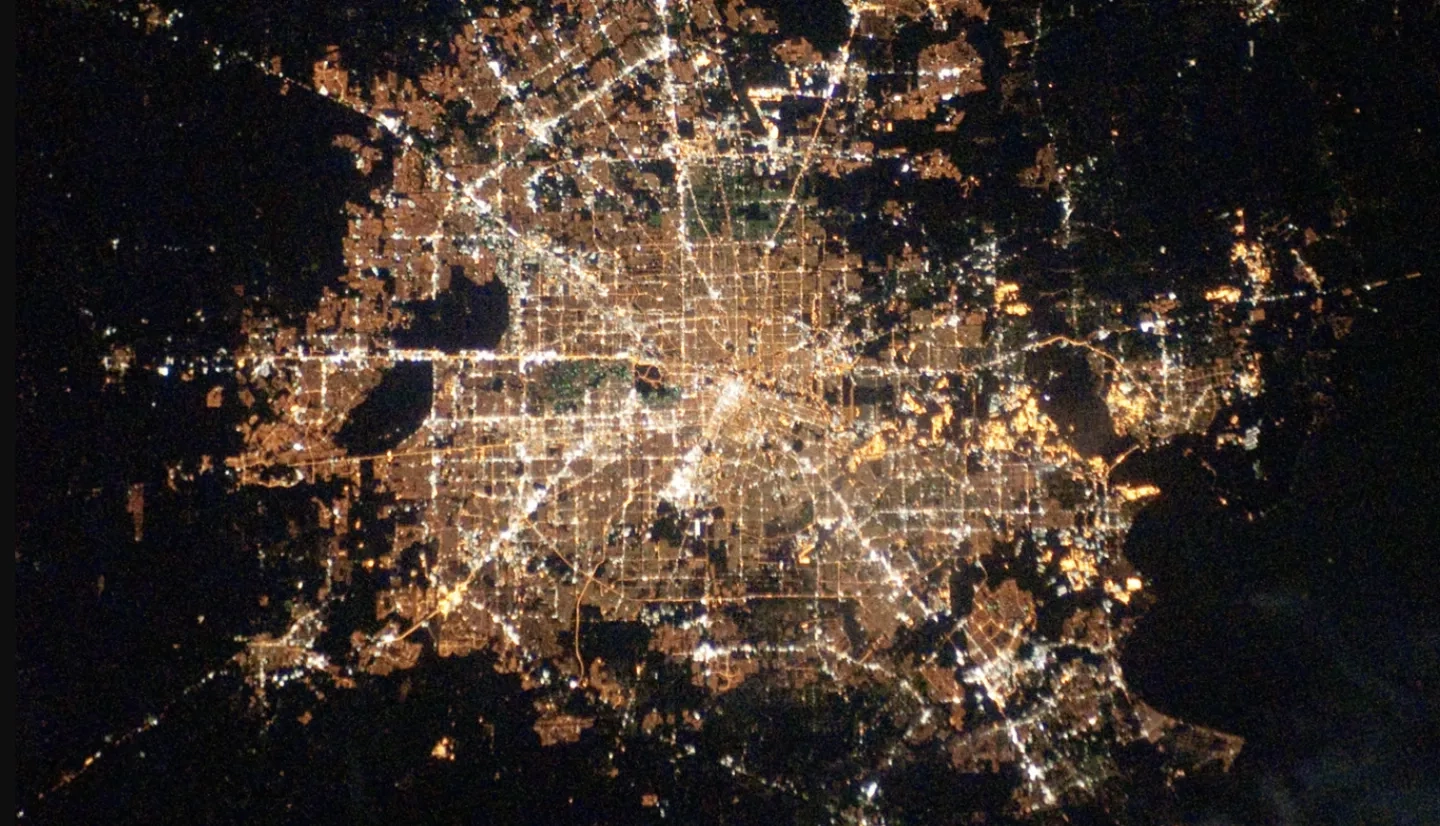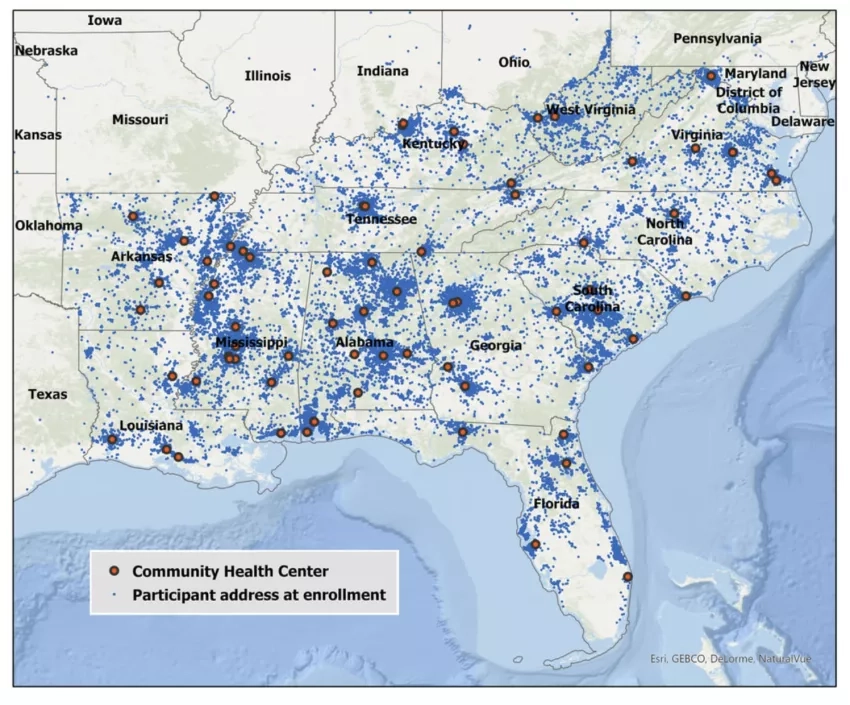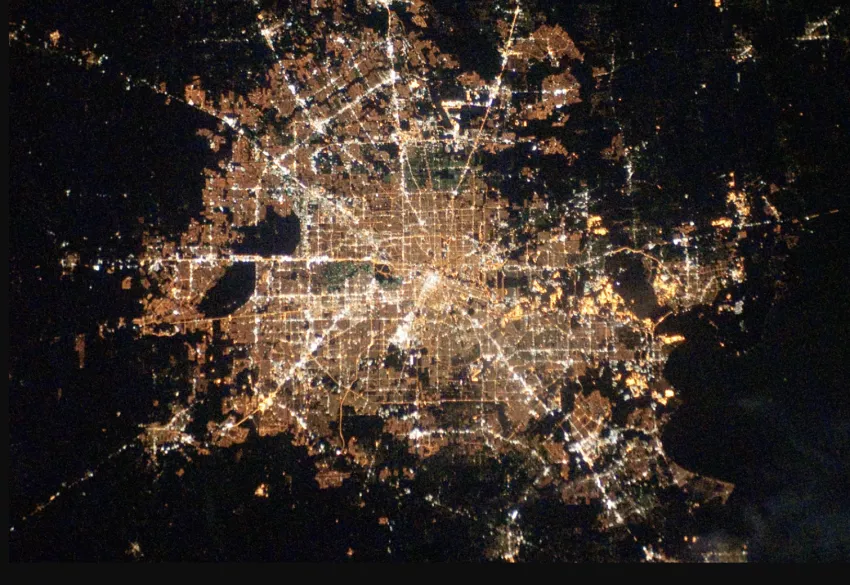Greatest harm seen in poorer areas
A newly emerging field of study is connecting the bright lights of U.S. cities at night to poorer human health. While this light affects everyone’s health, Qian Xiao and her team at UTHealth Houston School of Public Health, found that poorer, non-white neighborhoods are brighter.
“This exposure to artificial light is not universal,” Xiao said.
“There are places in cities that are exposed to a higher level of light at night and those places are often where minority, disadvantaged populations live, so there is a disparity there. That’s where the environmental justice aspect comes into play.”
Xiao and her team combined NASA nightlight data with health data from the U.S. Centers for Disease Control and Prevention (CDC). They created a series of ‘toolkits’ with the support of the Applied Sciences’ Health and Air Quality program area. These online maps have a user-friendly interface that allows people to see the overlay of light at night with existing national and state health information.
NASA’s fleet of Earth science satellites and images from the International Space Station make up the data set of nightlights. The CDC health information is called the “social vulnerability index.” It includes socioeconomic status, the racial makeup of a neighborhood, and other census information related to housing and transportation.
Rhythm and light
Xiao says the connection between poor health and bright artificial light is well-established.
“We humans, all animals really, have what’s called a circadian rhythm. The Earth has a 24-hour cycle of dark and light, and our biological system has adapted to this,” she said.
“So, when we have too much light at night, our biological clock does not react very favorably. It causes subtle changes that you won’t feel on a day-to-day basis. What we’ve found is that it leads to a lot of health consequences down the road, like cognitive decline, heart disease, cancer.”
Xiao is an epidemiologist at UTHealth Houston School of Public Health in the Human Genetics and Environmental Sciences department. Her focus is the health consequences of sleep deficiency and circadian dysfunction. NASA’s Applied Sciences’ Health and Air Quality Applied Sciences Team (HAQAST) supports her research and the creation of the online dashboard of data.
“The resolution of our data is neighborhood to neighborhood,” Xiao said. “Our group has constructed a dashboard with maps that summarize county and neighborhood-level lights at night. And we’ve shared both data sets with the CDC and with NASA.”
Black and White Differences
More than 99 percent of the U.S. population lives in areas where the night sky is considered polluted with artificial light, Xiao said. Several studies link bright outdoor artificial lights to a 10 to 14 percent increased chance in the risk of developing breast cancer.
Scientists believe the reason may be because the lights inhibit nighttime production of melatonin. Often associated with sleep, melatonin affects the process by which normal cells turn into cancer cells. But these studies were in groups mostly comprised of white women with relatively high socioeconomic status. So, Xiao and her colleagues looked for a similar connection between lights at night and the risk of breast cancer in Black women and people in lower socioeconomic groups.
They compared NASA data of artificial light at night with health information collected from about 85,000 people in the Southeast U.S. Recognized as the Southern Community Cohort Study, more than two-thirds of the people in this group are African American.
The theory was that individuals with low socioeconomic status were more likely to have sleep disturbances and shorter sleep times due to poor housing conditions, high stress, and unpredictable daily schedules, all of which may exacerbate the effects of light at night. Moreover, because these people are more likely to be awake at night, they may have a higher level of exposure to artificial light than individuals with high socioeconomic status.
Xiao says that their research confirmed the earlier studies that there was an association between lights at night and an increased risk of breast cancer. Their observational studies, however, cannot establish a causal relationship between the two because there were many other factors that may be associated with greater light at night and have a greater effect on their breast cancer risk.
A Full Spectrum of Information
As to why disadvantaged neighborhoods are bright, Xiao says she believes there are a number of factors.
“Our study does not provide direct evidence as to why. But we can speculate. Cities have higher (population) density, and so there’s more structures there with lights on at night. In some places they have covers on streetlights, but there are more bare lights in poor neighborhoods,” she said.
“Interestingly I’ve been in contact with a local activist for smart lighting in Houston. And when she talked to the city council about lights at night, she realized that the police believe it is always better to have more light at night to make it easier for them to patrol the streets. On the other hand, some studies show that brighter night lights may be blinding due to glare and suggest better ways to directing light that allow illumination. So we really need to educate people about unintended consequences of light exposure at night.”
Xiao says that HAQAST is funding the dashboard updates and plans to include an annual light update. It also will continue to add light data from newer satellites.
“The next generation of light exposure measurements will include the full spectrum of light,” she said. Currently the images mostly track visible light with a longer wavelength. But Xiao adds that shorter wavelengths, like blue light, are not included.
“And our circadian system is most susceptible to blue light,” Xiao said. “So, we’re not seeing the light that we’re most susceptible to.”
Xiao says that with a full spectrum of light detection, she and others who work in the field will have a much better view of how artificial lights at night are affecting us.
NASA HAQAST recorded its public panel at its 2022 meeting in Houston. The recording is available here: Addressing New Challenges with Light at Night Data.
Banner image is Houston at night as acquired by the International Space Station in 2014.







